Prut campaign of Peter I
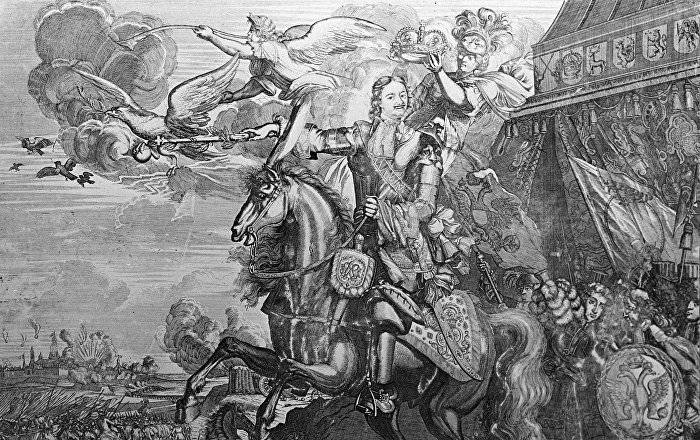
We do not like to talk about the Prut campaign of 1711. To completely forget about it, of course, does not work: its consequences were too heavy and too high a price had to be paid for it.
Remembering him, every time you feel a feeling of incomprehension and awkwardness: how could this have happened at all? In 1709, Russia won a triumphant victory over the strongest army in Europe at Poltava and without a fight captured its remnants at Perevolochnaya. In 1710, Russian troops again went from victory to victory, capturing seven important Baltic fortresses, including Vyborg, Riga and Revel. The Russian army increased in number and gained combat experience. And suddenly - such a failure in the war with the Turks, whose power was already declining.
In 1683, the Turks were defeated near Vienna, and the commander of their army as a trophy left Jan Sobesky the banner of the Prophet Muhammad.
In 1697, the young Austrian commander Yevgeny of Savoy defeated the Turks at Zenta, forcing Sultan Mustafa II to flee, forgetting about the harem.
In 1699, Turkey signed the Karlovatsk Peace Treaty with the Habsburgs, losing Hungary, Transylvania and most of Slavonia.
And even more: back in 1621, the Polish-Cossack army of Hetman Chodkiewicz found itself in a situation almost similar to that of Prut. Blocked by the superior forces of the Turks near Khotin on the banks of the Dniester, the Poles and Cossacks from September 2 to October 9 fought with superior enemy forces, lost the commander-in-chief, and ate all the horses. And what was the result? The Ottomans were forced to retreat - with shame and heavy losses.
And all of a sudden, the Turks, cramped on all fronts, had such a success in the fleeting war against the gaining strength of Russia.
Let's start our story in order.
On the eve of a new Russian-Turkish war
After an inglorious escape from the field of the Battle of Poltava, the Swedish king Charles XII, wounded in the heel, settled on the territory of the Ottoman Empire, in Bender. He was very well received by the Turkish authorities, who gave him and those accompanying him a generous allowance. The Ottomans hoped that upon recovery, the distinguished guest would immediately go to Sweden to continue the war with Russia. However, Karl was in no hurry to return to his homeland and for some reason did not feel much desire to fight the Russians again. Instead, he desperately intrigued, wanting to draw hospitable hosts into a war with dangerous Muscovites. The Sultan and his officials were no longer happy with such a guest, but all their attempts to honor him from the territory of their country were in vain. It all ended in a real battle between Charles XII and the janissaries who guarded him:
And moss overgrown steps
They say about the Swedish king.
The mad hero reflected them
Alone in the crowd of domestic servants
Turkish rat attack noisy
And threw the sword under the bunchuk.
A. S. Pushkin.
But all this was described in detail in the article "Vikings" against the Janissaries. The Incredible Adventures of Charles XII in the Ottoman Empire ", we will not repeat ourselves.
However, in the capital of the Ottoman Empire, Charles found allies. Among them were the Grand Vizier Baltaci Mehmet Pasha, who recently came to power, the mother of Sultan Ahmet III and the French ambassador Desalier. And in the Crimea at that time the slightly over-spent Khan Devlet-Girey II dreamed of another predatory campaign.
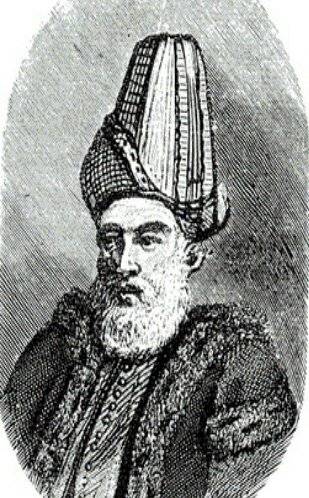
For some time their intrigues were successfully resisted by the Russian ambassador P.A.Tolstoy. Seeking compliance with the provisions of the Peace Treaty of Constantinople in 1700, he then had to spend a lot of Swedish gold captured near Poltava.
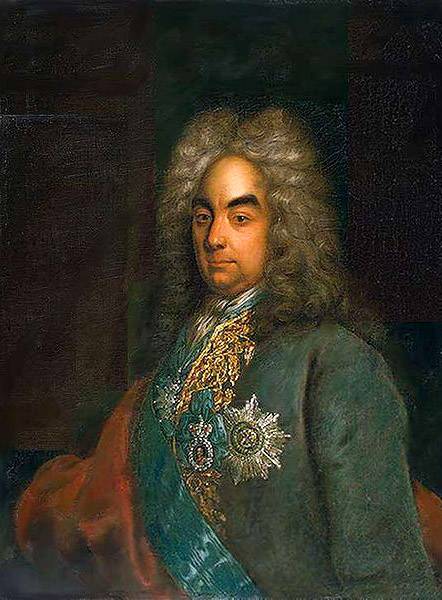
The supporters of the war still managed to persuade Sultan Ahmet III of the expediency of starting hostilities. Among the weighty arguments was, by the way, the need to remove the restless janissaries from the capital: in the Ottoman Empire they knew very well how janissary riots usually end. And the moment for the start of hostilities was quite favorable: the main forces of the Russian army were involved in the far north.
On November 9, 1710, the Ottoman Empire declared war on Russia, after which P. Tolstoy and all his employees were imprisoned in the Seven Towers Castle (Edikule). The Tsar's ambassador was seated on an old gelding and taken throughout the city, for the amusement of the raging crowd that insulted him.
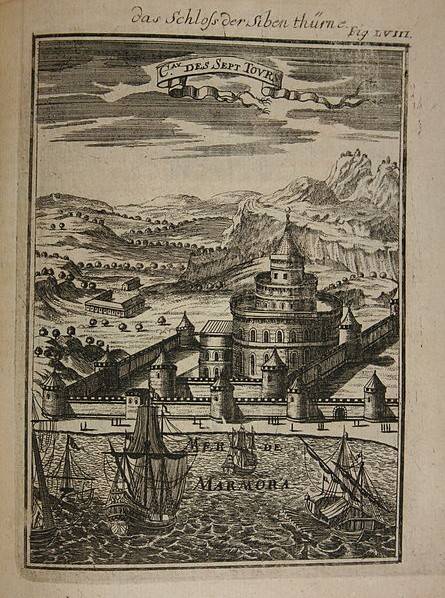
The beginning of the Prut campaign
Military operations began in January 1711 with the raids of the Crimean Tatars on the Ukrainian lands subject to Russia.
For the war in the southern direction in the Baltic States, an 80-strong army was formed, at the head of which Peter I put B. Sheremetyev.
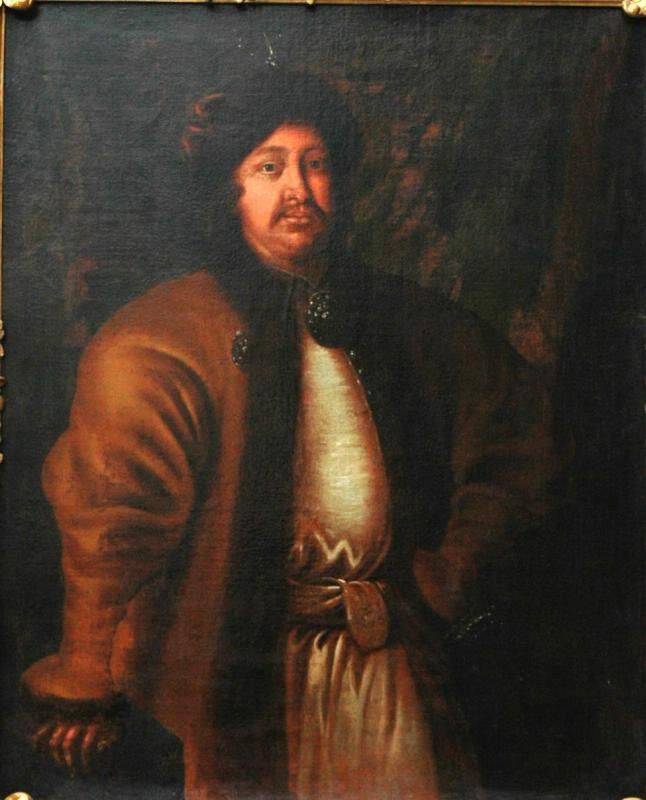
On January 10, 1711, this army set out from Riga. In addition to Field Marshal Sheremetyev, there were seven generals, including Y. Bruce and A. Repnin, who distinguished themselves at Poltava. Following the main forces, the guard, led by the emperor himself, also moved.
What was Peter's plan?
Here we will have to state with regret that the Russian emperor was then noted for obvious dizziness from success. Instead of choosing defensive tactics on the new front, giving the Turks the opportunity to go forward, losing both people and horses, suffering from infectious diseases, hunger and thirst (that is, in fact, repeating the recent military campaign against the Swedes, crowned with tremendous success near Poltava and Perevolnaya) , the emperor suddenly took the path of Charles XII, deciding to defeat the enemy with one valiant blow on his territory.
And even the Russian emperor suddenly found their own Mazepa. These are two rulers: Wallachian Constantin Brankovan (Brynkovianu) and Moldovan Dmitry Cantemir. They promised not only to provide the Russian army with food and fodder, but also to raise an anti-Turkish uprising in their lands. And there, according to Peter, the Bulgarians, as well as the Serbs and the Montenegrins should have pulled themselves together. Peter wrote to Sheremetyev:
The level of manilovism just rolls over.
Peter's hopes for the allied rulers were so great that warehouses ("shops") on the border with the Ottoman Empire were not prepared in advance, and food and fodder, according to Russian sources, were taken only for 20 days.
However, the French officer Moro de Brazet, who took part in the Prut campaign as commander of the dragoon brigade, in his book published in 1735, argued that supplies were taken only for 7-8 days:
In addition to everything, the Russian army in this campaign was accompanied by a huge number of people who had nothing to do with military service. According to the testimony of the same de Brazet, in the wagon train of the Russian army there were "more than two thousand five hundred carriages, carriages, small and large carts," in which the wives and family members of generals and senior officers were traveling. And part of the transport carriages of the Russian army turned out to be occupied not with "coarse soldiers' supplies" like crackers and cereals (which were not taken enough anyway), but with more refined products and wine for the "noble class".
But with whom was Tsar Peter going to go against the Turks? It turns out that by that time there were not so many veterans of Lesnaya and Poltava in the Russian regiments. Some of them died during the campaign of 1710, especially during the heavy siege of Riga, even more - from various epidemics. There were many sick and wounded. So in the army, which was supposed to go on a difficult campaign, every third soldier turned out to be a recruit of the first year of service. Another important factor in the future failure was the small number of Russian cavalry: taking into account the Tatar horsemen, the superiority of the enemy cavalry was simply depressing: according to this indicator, the Turkish-Tatar troops outnumbered the Russians by about 10 times.
From Kiev, the Russian army moved to the Dniester, intending to further go to the Danube - to Wallachia.
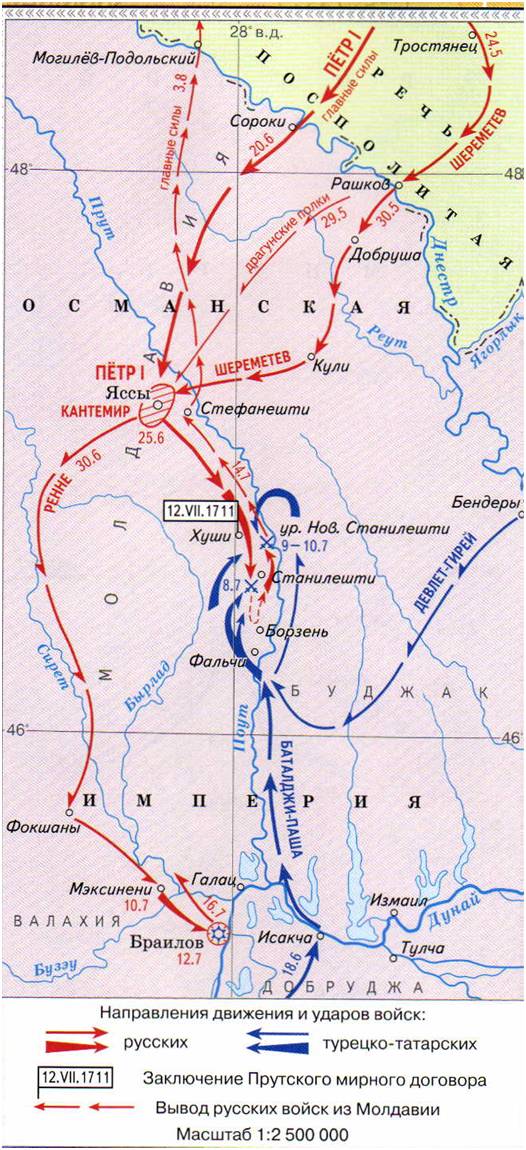
Russian troops beyond the Dniester
On June 12 (23), 1711, the Russian army reached the Dniester. At a military council on June 14 (25), General Ludwig Nikolai von Allart (a Scot in the Russian service) announced the danger of a repetition of the Ukrainian campaign of the Swedish king Charles XII and offered to take up positions on the Dniester, waiting for the Turks at the crossing.
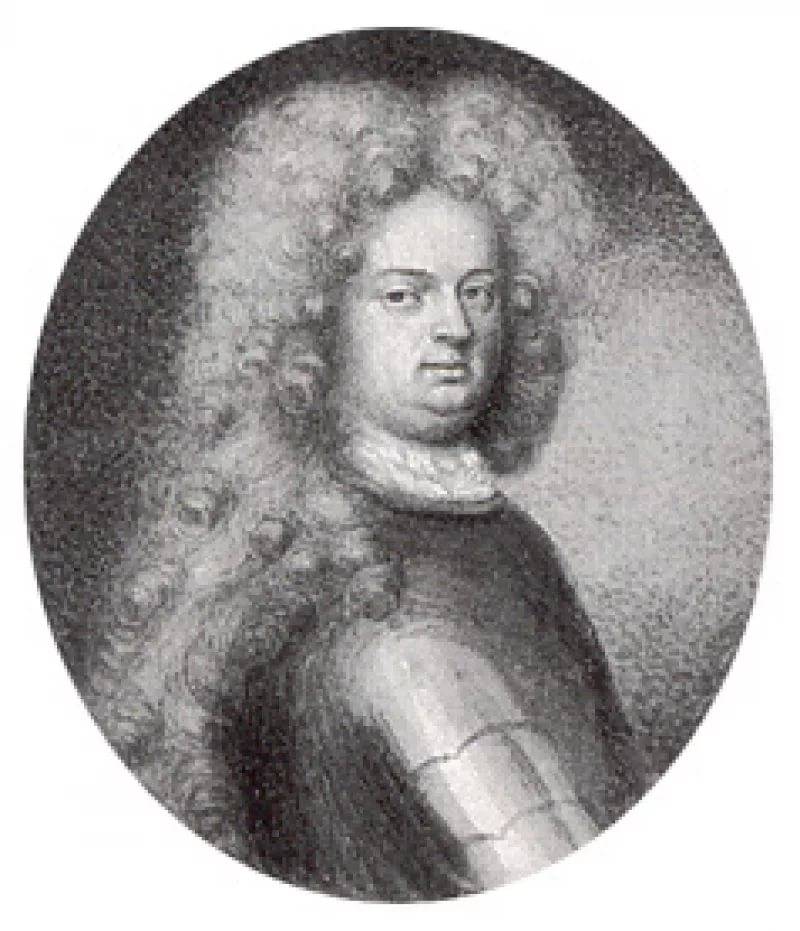
But Peter I, still hoping for the allied rulers, rejected this reasonable proposal.
On June 27 (16), Russian troops crossed the Dniester, on July 14 they reached the Prut River, where at the inspection on July 17, horrifying facts were revealed: without engaging in battles and without firing a single shot, the army lost 19 thousand people on the way, who died from various diseases, hunger and thirst. About 14 thousand soldiers left to guard communications did not reach the Prut either. The hopes for food and fodder, which were to be delivered by the local rulers, did not materialize. Brankovan completely abandoned plans to fight against the Ottomans, which did not save him from execution, which followed after the Ottomans became aware of the negotiations of this ruler with Peter I. Cantemir, due to a severe drought and the invasion of locusts, did not provide the promised supplies of food, but with himself led about 6 thousand ragamuffins (some of them were armed with spears and bows).
In this situation, the army had to simply be saved - taken back, and the sooner the better. Or at least stay in place, putting the troops in order and waiting for the enemy in a prepared position, as General Allart had suggested earlier. Instead, Peter ordered to continue moving towards Wallachia - along the right (northern) bank of the Prut River, while also dividing his forces. General K. Renne, in whose detachment was half of the Russian cavalry, went to the Danube fortress Brailov, which he managed to take - only to surrender it soon under the terms of a humiliating peace treaty.
And on the left bank at that time the superior forces of the Turkish army were already marching towards the Russians.
The beginning of hostilities
Few people know that Charles XII reached such impudence that he demanded from the Sultan no less command over the Turkish army! Here the grand vizier of Baltaji Mehmet Pasha, who, according to his rank, was to lead this campaign, was already outraged. Calling Karl behind the back of his eyes "an arrogant wicked", he offered him only to accompany the Ottoman army - and this offer offended the already proud Swede. Instead of himself, he sent two generals: the Swedish Sparre and the Polish Poniatowski (representative of King S. Leszczynski). By the way, he later regretted this very much, since at the decisive moment of negotiations with the Russians he was too far away and could not influence the vizier's decision. But let's not get ahead of ourselves.
So, the Russian army, moving along the right bank of the Prut, was overtaken by the enemy on the march and was locked in a narrow valley of this river. The balance of power at that time was as follows.
Russians have 38 thousand people against 100-120 thousand Turks and 20-30 thousand Tatars. The enemy also had an advantage in artillery: from 255 to 407 (according to various sources) guns in the Ottoman army and 122 guns in the Russian.
The ratio of equestrian units was very sad: for 6,6 thousand Russian cavalry there were more than 60 thousand Turkish and Tatar.
On July 18, the Turkish cavalry, which crossed to the right bank of the Prut, attacked the vanguard of the Russian army. About 6 thousand Russian soldiers, who had 32 guns at their disposal, lined up in a square, in complete encirclement, moved to the main army, with which they managed to unite on the morning of July 19. On the same day, the Turkish cavalry completed the encirclement of the Russian troops, but did not accept the battle, not approaching the Russian positions closer than 200-300 steps.
And only then did Peter I and his generals think about retreating and choosing a suitable position. At 11 o'clock in the evening, Russian troops in six parallel columns moved upstream the Prut, covering themselves from the enemy cavalry with slingshots, which the soldiers carried in their arms.
On the morning of July 20, a gap formed between the left (guards) column and the neighboring division, and the Turks attacked the wagon train between them. Fighting off this attack, the Russian army stopped for several hours. As a result, the janissaries with artillery managed to come to the aid of their cavalrymen, and at about 5 o'clock in the afternoon the Russian army was pressed against the Prut River, on the opposite bank of which the Tatars came out.
On July 20, the Janissaries made three attempts to attack the Russian camp, the first of which turned out to be especially fierce, but were repulsed.
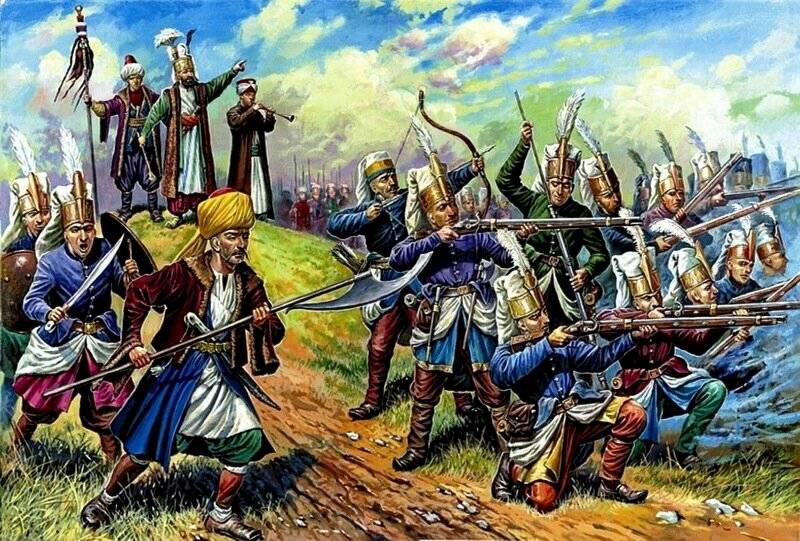
On that day, General Allart was wounded, and Field Marshal Sheremetyev, according to eyewitnesses, coming out from behind the slingshots, personally killed a Turk and captured his horse, which he later presented to Catherine.
Having lost 7 thousand people, the Janissaries refused to continue the offensive. The French agent La Motreuil, who was in the Turkish army at the time, testifies:
The Polish general Poniatowski claims that kegaya (deputy commander in chief) told him then:
British Ambassador Sutton wrote:
The head of the Janissary corps reported to the Sultan about the same:
However, Peter I, fearing the capture of the convoy by the Turkish cavalry, did not dare to give such an order.Then he canceled the night attack, approved by the military council, which, very likely, would have caused panic in the Ottoman army and could lead to its retreat and even flight.
A new attack on the Russian positions, undertaken by the Turks on the morning of the next day, was also unsuccessful.
The situation was very interesting. The Russian troops were in a desperate situation (mainly due to the lack of food and fodder). But the Turks, not knowing this, were frightened by the fierce resistance of the enemy and the effectiveness of his actions (especially artillery units) and were already beginning to doubt the successful outcome of the upcoming big battle. Proposals for the need to conclude peace were expressed in the camps of both sides.
In the next article, we will talk about the peace negotiations between the Russians and the Turks and some historical legends associated with them, let us finish the story about the tragic Prut campaign and its sad consequences.
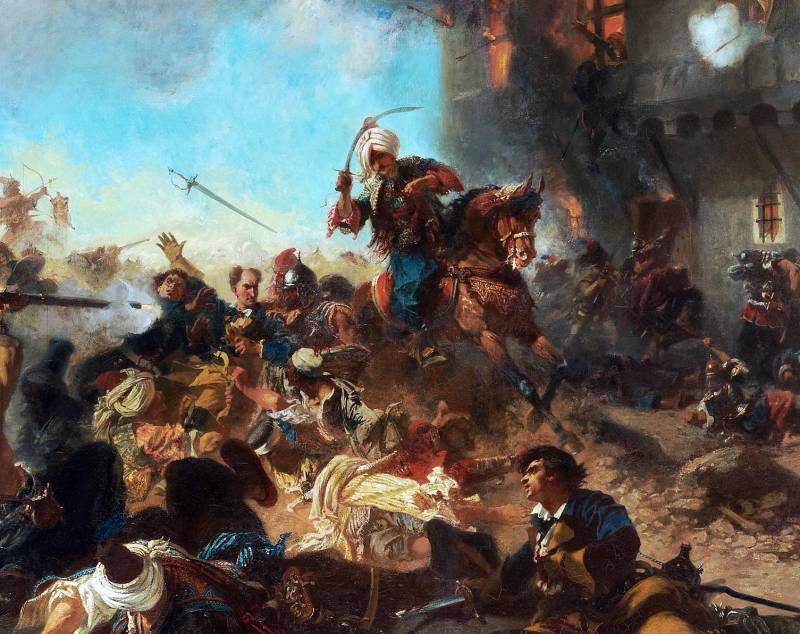
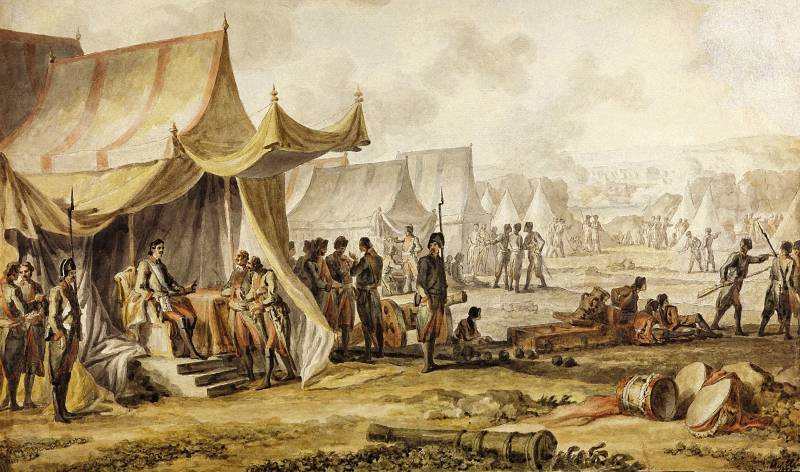
Information